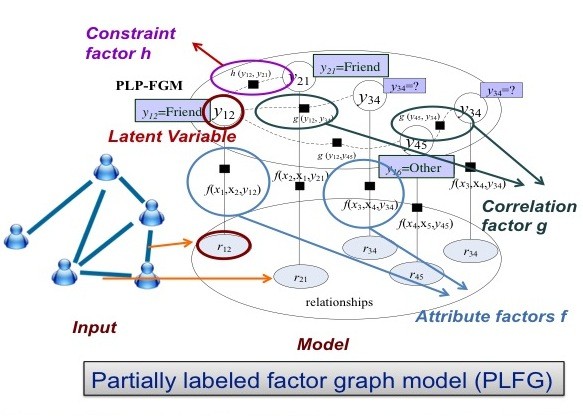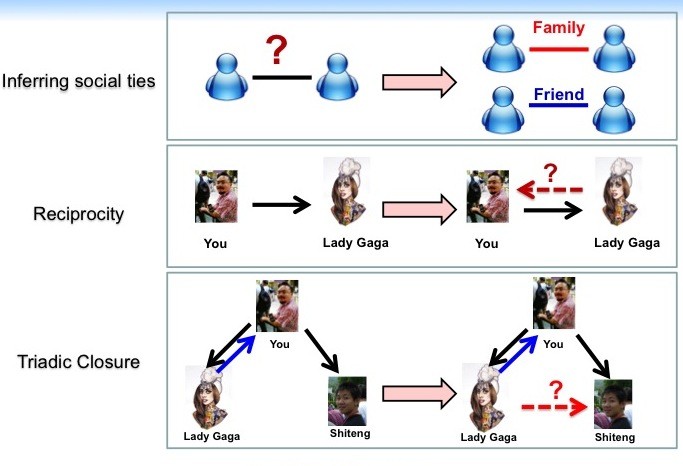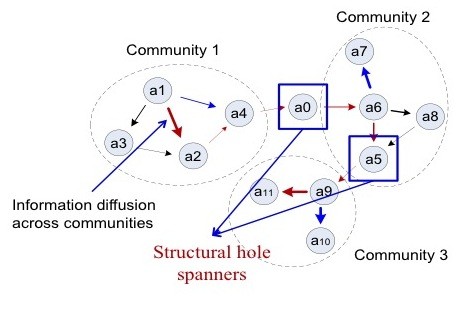
Factor graph is one type of probabilistic graphical models, providing an elegant way to represent both undirected graphical structure and directed graphical structure, with more emphasis on the factorization of the distribution.
Online social networks are getting larger and machine learning tasks are facing several challenges:
(1) labeled data is insufficient and how to leverage the unlabeled data for learning a graphical model?
(2) how to leverage the correlation and the network information to help build the graphical model?
We design two categories of factor graph models. The first category is for unsupervised learning. We have proposed Topical Factor Graph (TFG) (Tang et al., KDD'09), Time-constrained Probabilistic Factor Graph model (TPFG) (Wang et al., KDD'10). The second category is for supervised learning. We have proposed Partially Labeled Factor Graph model (PLFG) (Zhuang et al., DMKD'12), Triad-based Factor Graph model (TriFG) (Lou et al., TKDD'12), Transfer-based Factor Graph model (TranFG) (Tang et al., WSDM'12).
Related codes:
[Partially Labeled Factor Graph readme. Refer to Web page or Tang et al. PKDD'11 for details.]
[Topic Affinity Propagation. Refer to Web Page or Tang et al. KDD'09 for details.]
创建: Apr 11, 2018 | 20:41

In online social networks, social relationship is the most basic unit to form the network structure. Relationships between users can be either directed or undirected.
We focus on studying two aspects of social tie: (1) to which extent the label of social ties between people can be inferred in social networks? (2) how reciprocal (two-way) relationships are developed from parasocial (one-way) relationships and how the relationships further develop into triadic closure and communities? (3) how communities dynamically evolve over time?
We propose a unsupervised dynamic factor graph model to infer advisor-advisee relationship from the coauthor network (Wang et al., KDD'10) and a partially labeled factor graph model to infer the type of social relationships (Tang et al., ECML/PKDD'11, PKDD Best Student Paper Runnerup). We further incoporate social theories (e.g., social balance theory, social status theory, structural hole theory, two-step flow theory, and strong/weak tie) into a triad-based factor graph model to infer the formation of reciprocal relationships from parasocial relationships (Hopcroft et al., CIKM'11) and to infer the formation of triad closure (Lou et al., TKDD'13), and leverage features defined based on those social theories to infer social ties across heterogeneous networks (Tang et al., WSDM'12). We have further proposed a co-evolution model for modeling the dynamic changes of communities in social networks (Sun et al., TKDE'13).
Related data sets and codes: [Social-Tie] [Reciprocity&Triadic Closure]
Invited talks were given at different venues and related slides can be downloaded here. [PDF]
创建: Apr 11, 2018 | 20:41

The theory of structural holes suggests that individuals would benefit from filling the ``holes'' (called as structural hole spanners) between people or groups that are otherwise disconnected.
The fundamental challenge we want to address is to detect users who span structural holes in social networks and how the structural hole spanners influence the information diffusion?
We explore the problem of mining structural hole spanners through information diffusion in social networks (Lou and Tang, WWW'13). We precisely define the problem of mining top-k structural hole spanners in large-scale social networks and provide an objective (quality) function to formalize the problem. Two instantiation models (HIS and MaxD) have been developed to implement the objective function. The optimization is proved to be NP-hard, and we design an efficient algorithm with provable approximation guarantees.
Related data sets and codes: [Structural hole&Information diffusion]
创建: Apr 11, 2018 | 20:41

Social influence occurs when one's opinions, emotions, or behaviors are affected by others, intentionally or unintentionally. There are three major research topics in social influence: test, measure, and model.
Our research mainly focuses on quantifying the influential strength between users in large social networks. We try to answer several challenging questions: (1) How to differentiate the social influences from different angles(topics)? (2) How to quantify the strength of those social influences? (3) How to estimate the model on real large networks?
We propose Topical Affinity Propagation (TAP) to model the topic-level social influence on large networks (Tang et al., KDD'09) and investigate a new problem of conformity influence analysis (Tang et al., KDD'13). We also study the conservative and non-conservative influence propagation over heterogeneous networks (Liu et al., DMKD'12) and propose the notion of social influence locality for modeling retweeting behaviors (Zhang et al., IJCAI'13). We further propose a NTT-FGM model to formalize social influence, correlation (homophily), and users' action dependency into a unified approach and distinguish their effects for modeling and predicting users' actions in social networks (Tan et al., KDD'10). And apply social influence for analyzing user-level sentiment in social networks (Tan et al., KDD'11).
Related data sets and codes: [Topic-Influence] [Influence-over-Heterogeneous-Networks] [Social-Action-Tracking]
Tutorials are given at WWW'14, WSDM'13 and ASONAM'12, and can be downloaded here [Slides] [PDF].
A survey of models and algorithms for social influence analysis can be found here.
创建: Apr 11, 2018 | 20:40




